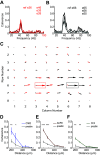Coherent olfactory bulb gamma oscillations arise from coupling independent columnar oscillators
- PMID: 38264784
- PMCID: PMC7615692
- DOI: 10.1152/jn.00361.2023
Coherent olfactory bulb gamma oscillations arise from coupling independent columnar oscillators
Abstract
Spike timing-based representations of sensory information depend on embedded dynamical frameworks within neuronal networks that establish the rules of local computation and interareal communication. Here, we investigated the dynamical properties of olfactory bulb circuitry in mice of both sexes using microelectrode array recordings from slice and in vivo preparations. Neurochemical activation or optogenetic stimulation of sensory afferents evoked persistent gamma oscillations in the local field potential. These oscillations arose from slower, GABA(A) receptor-independent intracolumnar oscillators coupled by GABA(A)-ergic synapses into a faster, broadly coherent network oscillation. Consistent with the theoretical properties of coupled-oscillator networks, the spatial extent of zero-phase coherence was bounded in slices by the reduced density of lateral interactions. The intact in vivo network, however, exhibited long-range lateral interactions that suffice in simulation to enable zero-phase gamma coherence across the olfactory bulb. The timing of action potentials in a subset of principal neurons was phase-constrained with respect to evoked gamma oscillations. Coupled-oscillator dynamics in olfactory bulb thereby enable a common clock, robust to biological heterogeneities, that is capable of supporting gamma-band spike synchronization and phase coding across the ensemble of activated principal neurons.NEW & NOTEWORTHY Odor stimulation evokes rhythmic gamma oscillations in the field potential of the olfactory bulb, but the dynamical mechanisms governing these oscillations have remained unclear. Establishing these mechanisms is important as they determine the biophysical capacities of the bulbar circuit to, for example, maintain zero-phase coherence across a spatially extended network, or coordinate the timing of action potentials in principal neurons. These properties in turn constrain and suggest hypotheses of sensory coding.
Keywords: multielectrode arrays; neural circuit; optogenetics; slice electrophysiology; synchronization.
Conflict of interest statement
No conflicts of interest, financial or otherwise, are declared by the authors.
Figures








Similar articles
-
Odor encoding by fine-timescale spike synchronization patterns in the olfactory bulb.J Neurophysiol. 2025 Jul 1;134(1):274-286. doi: 10.1152/jn.00340.2024. Epub 2025 Jun 14. J Neurophysiol. 2025. PMID: 40517018 Free PMC article.
-
A coupled-oscillator model of olfactory bulb gamma oscillations.PLoS Comput Biol. 2017 Nov 15;13(11):e1005760. doi: 10.1371/journal.pcbi.1005760. eCollection 2017 Nov. PLoS Comput Biol. 2017. PMID: 29140973 Free PMC article.
-
Circuit properties generating gamma oscillations in a network model of the olfactory bulb.J Neurophysiol. 2006 Apr;95(4):2678-91. doi: 10.1152/jn.01141.2005. Epub 2005 Dec 28. J Neurophysiol. 2006. PMID: 16381804
-
Circuit oscillations in odor perception and memory.Prog Brain Res. 2014;208:223-51. doi: 10.1016/B978-0-444-63350-7.00009-7. Prog Brain Res. 2014. PMID: 24767485 Review.
-
The olfactory bulb: coding and processing of odor molecule information.Science. 1999 Oct 22;286(5440):711-5. doi: 10.1126/science.286.5440.711. Science. 1999. PMID: 10531048 Review.
Cited by
-
A Systematic Framework for Olfactory Bulb Signal Transformations.Front Comput Neurosci. 2020 Sep 23;14:579143. doi: 10.3389/fncom.2020.579143. eCollection 2020. Front Comput Neurosci. 2020. PMID: 33071767 Free PMC article.
-
Generative Biophysical Modeling of Dynamical Networks in the Olfactory System.Methods Mol Biol. 2018;1820:265-288. doi: 10.1007/978-1-4939-8609-5_20. Methods Mol Biol. 2018. PMID: 29884952 Free PMC article.
-
Dendritic integration in olfactory bulb granule cells upon simultaneous multispine activation: Low thresholds for nonlocal spiking activity.PLoS Biol. 2020 Sep 23;18(9):e3000873. doi: 10.1371/journal.pbio.3000873. eCollection 2020 Sep. PLoS Biol. 2020. PMID: 32966273 Free PMC article.
-
Olfactory bulb granule cells: specialized to link coactive glomerular columns for percept generation and discrimination of odors.Cell Tissue Res. 2021 Jan;383(1):495-506. doi: 10.1007/s00441-020-03402-7. Epub 2021 Jan 6. Cell Tissue Res. 2021. PMID: 33404844 Free PMC article.
-
Rapid online learning and robust recall in a neuromorphic olfactory circuit.Nat Mach Intell. 2020 Mar;2(3):181-191. doi: 10.1038/s42256-020-0159-4. Epub 2020 Mar 16. Nat Mach Intell. 2020. PMID: 38650843 Free PMC article.
References
Publication types
MeSH terms
Associated data
Grants and funding
LinkOut - more resources
Full Text Sources

